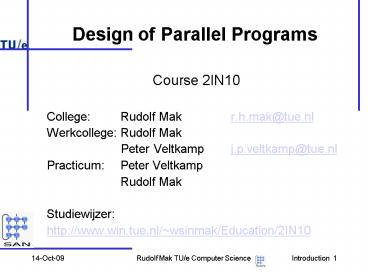Introduction 1 - PowerPoint PPT Presentation
1 / 14
Title:
Introduction 1
Description:
Rudolf Mak TU/e Computer Science. Introduction 2. Course ... nous simultaneous stimuli from its environment. 9/5/09. Rudolf Mak TU/e Computer Science ... – PowerPoint PPT presentation
Number of Views:49
Avg rating:3.0/5.0
Title: Introduction 1
1
Design of Parallel Programs
- Course 2IN10
- College Rudolf Mak r.h.mak_at_tue.nl
- Werkcollege Rudolf Mak
- Peter Veltkamp j.p.veltkamp_at_
tue.nl - Practicum Peter Veltkamp
- Rudolf Mak
- Studiewijzer
- http//www.win.tue.nl/wsinmak/Education/2IN10
2
Course organization
- Blok A
- 5 x 2 uur college
- 5 x 2 uur werkcollege
- Blok B
- 4 x 2 uur toelichting practicum opdrachten
- 4 x 2 uur practicum
- Afrekening
- Schriftelijk examen
- Practicum verslag
- Deelresultaten voorgaande jaren blijven geldig
3
Course Overview
- Scope and context of the course
- Concepts and definitions
- Specification and programming language
- Performance metrics
- Design strategies
- Finite linear systems
- Tree-like systems, infinite systems
4
Scope and Context
- Motivation
- Machine model
- Programming model
- Related literature
5
Motivation
- Two important branches of parallel computing are
- High performance computing
- This field is concerned with computationally
expensive - (scientific) computations. The main reason to
consider - parallelism is computation speed.
- Distributed computing
- This field is concerned with the control of
complex dis- - tributed systems. In this case parallelism is
inherent, - because the program has to react timely to
asynchro- - nous simultaneous stimuli from its environment.
6
Machine Models
- A machine model contains information about the
nature, - number, and performance characteristics of the
- Processing units
- Storage units
- Interconnection network
- The machine model influences the choice of
programming. - style and the performance analysis of programs.
7
Flynn Taxonomy
- Single Instruction Single Data (SISD)
- Single Instruction Multiple Data (SIMD)
- Multiple Instruction Single Data (MISD)
- Multiple Instruction Multiple Data (MIMD)
8
Multi-computer
A mesh-connected, distributed memory machine
(MIMD)
9
Multiprocessor (UMA)
A shared-memory machine with uniform memory access
10
Programming Model
- Important aspects of a model for parallel
programming are - Methodology
- algorithmic parallelism, data parallelism,
processor farming - Communication
- message passing or shared variables
- data dependent or data independent behavior
- Grainsize
- fine-grained or coarse-grained or parametric
grain size
11
Systolic Computation
- A systolic computation is a computation performed
on a - multi-computer, also called a systolic array,
that satisfies - the following criteria
- Cells are simple and communicate via a fixed
number of channels - Communication takes place via uni-directional
channels - The network is a regular arrangement of cells
- The communication behavior is independent of the
values sent and received - Cells synchronize by message passing only
12
What we do not discuss
- Mapping problem
- Reactive programs (probes, passive processes)
- Dependability
- Safety issues
- Real-time issues
13
Literature
- M.Rem, Lecture Notes in Parallel Programming,
TU/e dictaat nr 2519, 1995 ( included
references). - Michael J. Quinn, Parallel computing theory and
practice, McGraw-Hill, 1994. - Ian T. Foster, Designing and Building Parallel
Programs, Addison-Wesley, 1995. - Gregory R. Andrews, Foundations of Multithreaded,
Parallel, and Distributed Programming,
Addison-Wesley, 1999. - Ananth Grama et. al., Introduction to Parallel
Computing, Second Edition, Addison-Wesley, 2003.
14
Literature
- John L. Hennessy and David A. Patterson, Computer
Architecture A quantitative Approach, 2nd ed.,
Morgan Kaufmann, 1996. - Gregory F. Pfister, In Search of Clusters,
Prentice Hall, 1998. - Harry F. Jordan and Gita Alaghband, Fundamentals
of Parallel Processing, Prentice Hall, 2003. - David Skillikorn and Dominico Talia, Models and
languages for Parallel Computation, ACM Computing
Surveys, Vol. 30. Nmb 2, June, 1998.































